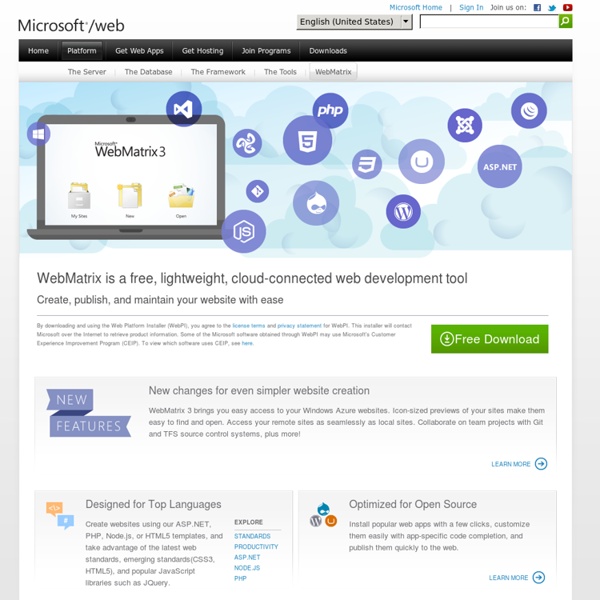



Joomla.fr Krita Flash Website Templates - FlashMint Hackasaurus Look ahead Learn all about Firefox OS » Welcome to Webmaker! That username is taken You must choose a username Invalid username. You must agree to our terms and conditions. X-Ray Goggles Remix and share web pages instantly Activate X-Ray Goggles See how Goggles work by swapping an image Copy this image URL (highlight the text below, right-click, then copy the link) The URL you just copied links to a new image! Share your remix When you're ready to share your remixed page, click the Publish button or press P on your keyboard. Help If you need help, make sure the X-Ray Goggles are activated, then press H on your keyboard. Remix any webpage! You can take X-Ray Goggles with you anywhere on the web: Make sure your web browser's bookmarks bar is enabled. Now visit any website on the internet.
Download the Microsoft Web Platform Overview The Microsoft Web Platform Installer - WebPI provides a simplified installation workflow for installing common open source web applications and web platform technologies The Microsoft Web Platform Installer is a free tool that makes it simple to download, install and keep up-to-date with the latest components of the Microsoft Web Platform, including Internet Information Services (IIS), SQL Server Express, .NET Framework and Visual Studio. Web PI also makes it easy to install and run the most popular free web applications for blogging, content management and more with the built-in Windows Web Application Gallery By clicking the Download links below, you agree to the license terms for the Microsoft Web Platform Installer. Download WebPI 5.0 English: x64 installer / x86 installer
Visual Studio Express 2012 Visual Studio Express 2012 pour le Web Microsoft Visual Studio Express 2012 pour le Web est un environnement de développement gratuit et fiable pour construire, tester et déployer des applications Web sur la plateforme Web de Microsoft. Visual Studio Express 2012 pour Windows 8 Microsoft Visual Studio Express 2012 pour Windows 8 fournit les outils de base nécessaires pour bâtir des applications Windows Store intéressantes et innovantes. Visual Studio 2012 Express pour Windows Desktop Vous pouvez utiliser Visual Studio Express 2012 pour Windows Desktop pour créer des applications de bureau puissantes en C#, Visual Basic et C++. Visual Studio Team Foundation Server Express 2012 Même les petites équipes peuvent obtenir de grands résultats.
11 sites gratuits pour créer son logo professionnel Concevoir le design d’un logo pour son entreprise est une des tâches les plus difficiles. Votre logo doit être unique, simple, créatif, original et professionnel. Il a pour but d’identifier de manière unique et immédiate votre société. Nombreuses sont les sociétés qui recherchent comment créer leur propre logo. Je vous propose 11 sites de création de logo gratuit : Mais avant de vous lancer je vous propose la lecture de notre article précédent : 30 conseils pour réaliser un logo parfait Je viens de découvrir un nouveau site web pour vous aider a créer votre logo professionnel en ligne. Service de création de logo en ligne, Logaster génère des dizaines de logos prêt à être utilisé, il vous suffit d’entrer un nom de société et d’ajouter un type d’entreprise. Logiciel en ligne pour la création d’un logo professionnel gratuit. Ceci est le créateur de logos de Vistaprint.
25+ Most Popular Free Flash XML Photo Galleries In Current time Flash Media (Swf) is used in almost every website. And If there is an image presentation then flash presentation is the best way to showcase them. As Flash is very much interactive, it gives a visual push to the site. WS-Slideshow Art Flash Gallery Zen Flash Gallery Flash Mo Grid Gallery Photo Flow Flash Gallery InventMedia FlashGallery Box Photo Gallery Polaroid Gallery DfGallery 2.0 FlShow Carousel XML Image Gallery With Source Download Here Flash Page Flip Photo Gallery template for Picasa Build a Dynamic Flash Gallery with Slider Control 3D Flash image viewing PostcardViewer Prometeus 3D PhotoGallery AutoViewer Free Flash & XML Photo Album with Categories Flash Gallery Agile Gallery Flash Photo Stack Gallery FlashMo Circle Gallery Flashmo 3d Grid Slideroll Gallery AV Simple Viewer Learn how to design a webpage with help of our latest testking 000-973 tutorials and testking 1z0-048 study guides.
W3Schools Online Web Tutorials FileZilla client FTP